Strategic Analysis: Riverwood Logistics Challenges in Singapore
VerifiedAdded on 2023/06/08
|23
|5534
|324
Report
AI Summary
This business report examines the challenges faced by Riverwood Logistics in Singapore's logistics market, highlighting issues such as market fragmentation, rising customer expectations, and the impact of a VUCA (Volatility, Uncertainty, Complexity, Ambiguity) environment. The report conducts external and internal analyses, including PESTEL and RBV frameworks, to identify key disruptions hindering Riverwood's growth. It emphasizes the need for digital fitness, strategic collaboration, and efficient last-mile delivery solutions. Ultimately, the report suggests that severe market fragmentation and an excess of market players pose the most significant challenges, preventing Riverwood from achieving greater success in the competitive Singaporean logistics landscape. Desklib provides access to similar reports and study tools for students.
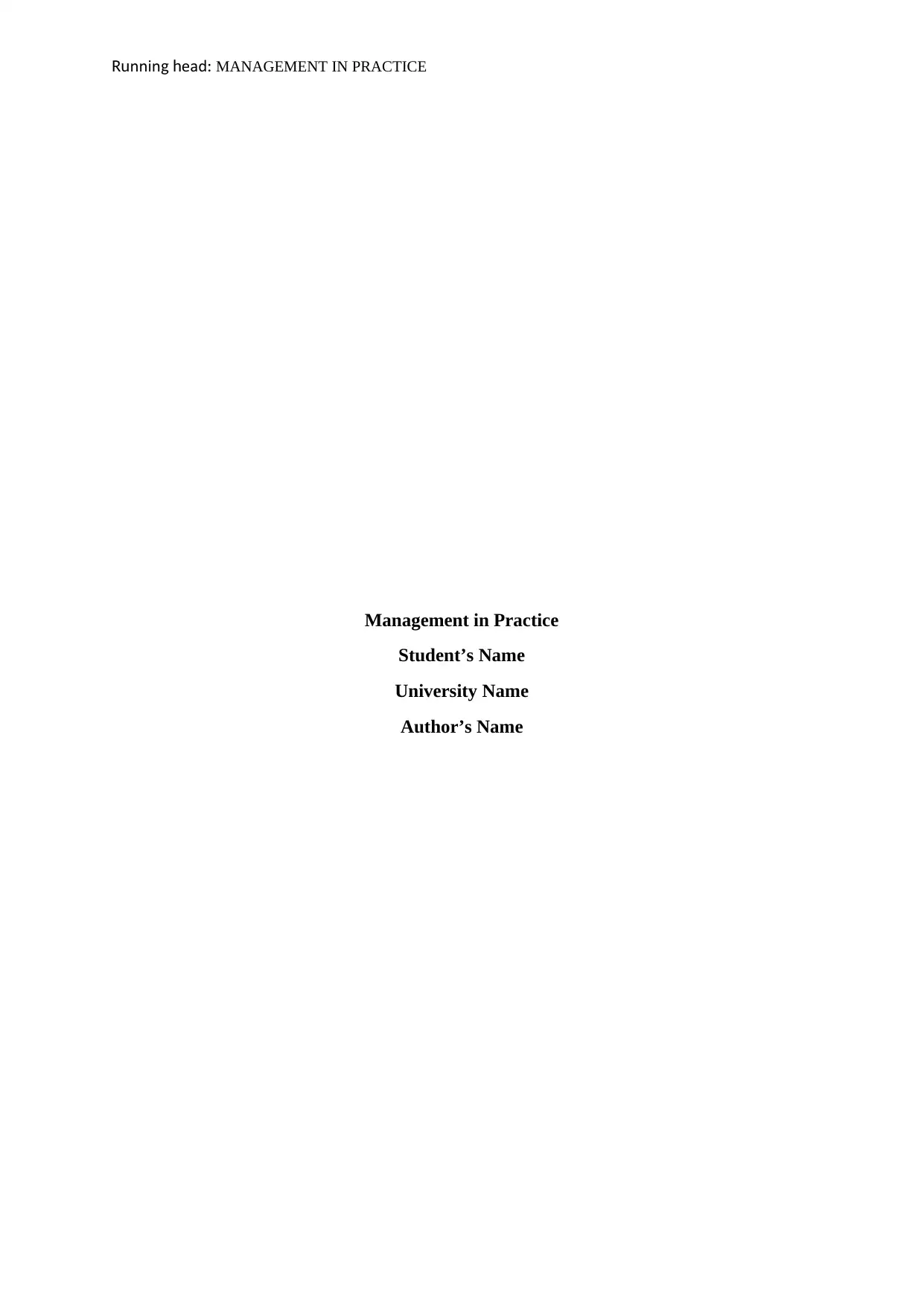
nnin eadRu g h : MANAGEMENT IN PRACTICE
Management in Practice
Student’s Name
University Name
Author’s Name
Management in Practice
Student’s Name
University Name
Author’s Name
Paraphrase This Document
Need a fresh take? Get an instant paraphrase of this document with our AI Paraphraser
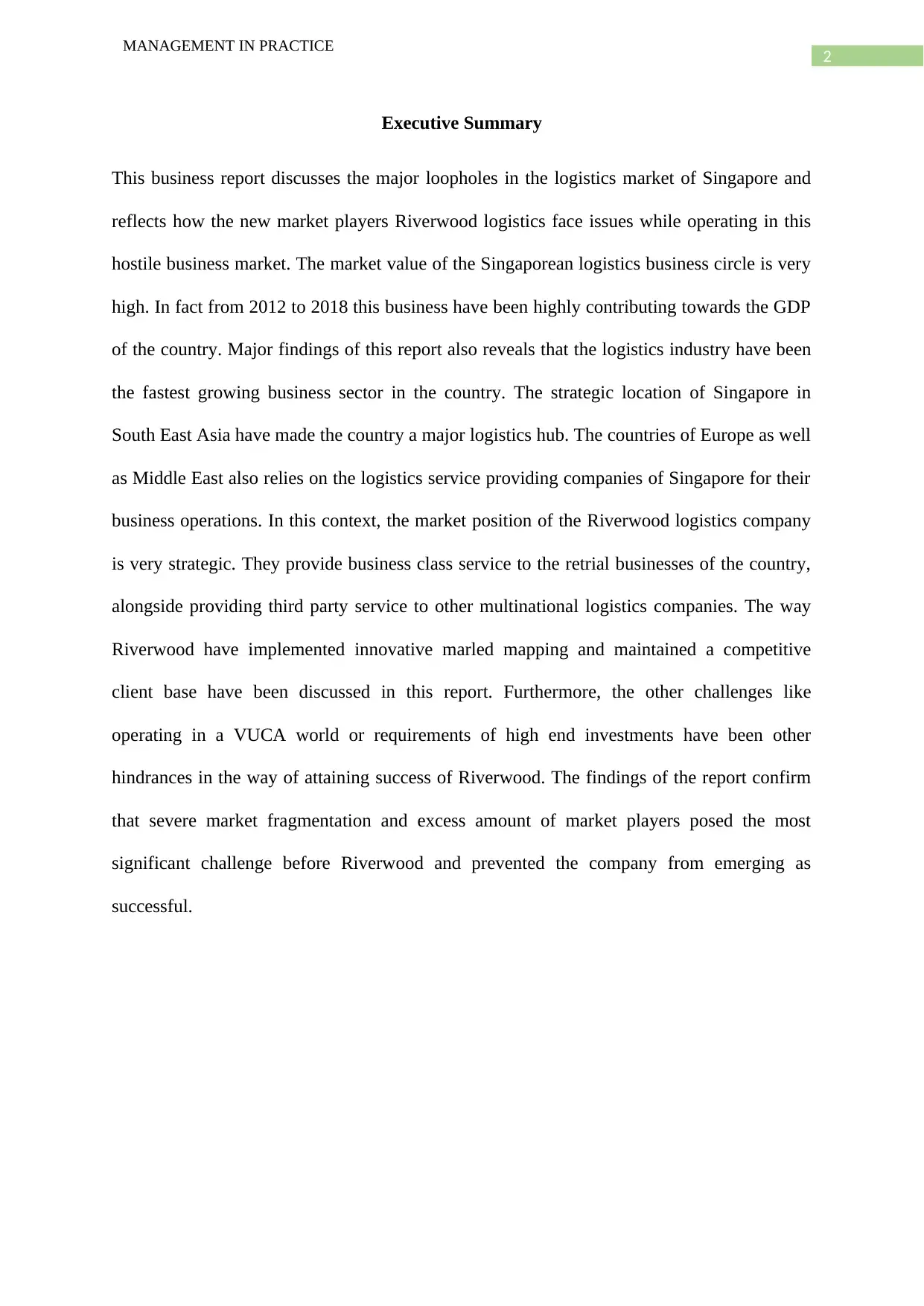
2
MANAGEMENT IN PRACTICE
Executive Summary
This business report discusses the major loopholes in the logistics market of Singapore and
reflects how the new market players Riverwood logistics face issues while operating in this
hostile business market. The market value of the Singaporean logistics business circle is very
high. In fact from 2012 to 2018 this business have been highly contributing towards the GDP
of the country. Major findings of this report also reveals that the logistics industry have been
the fastest growing business sector in the country. The strategic location of Singapore in
South East Asia have made the country a major logistics hub. The countries of Europe as well
as Middle East also relies on the logistics service providing companies of Singapore for their
business operations. In this context, the market position of the Riverwood logistics company
is very strategic. They provide business class service to the retrial businesses of the country,
alongside providing third party service to other multinational logistics companies. The way
Riverwood have implemented innovative marled mapping and maintained a competitive
client base have been discussed in this report. Furthermore, the other challenges like
operating in a VUCA world or requirements of high end investments have been other
hindrances in the way of attaining success of Riverwood. The findings of the report confirm
that severe market fragmentation and excess amount of market players posed the most
significant challenge before Riverwood and prevented the company from emerging as
successful.
MANAGEMENT IN PRACTICE
Executive Summary
This business report discusses the major loopholes in the logistics market of Singapore and
reflects how the new market players Riverwood logistics face issues while operating in this
hostile business market. The market value of the Singaporean logistics business circle is very
high. In fact from 2012 to 2018 this business have been highly contributing towards the GDP
of the country. Major findings of this report also reveals that the logistics industry have been
the fastest growing business sector in the country. The strategic location of Singapore in
South East Asia have made the country a major logistics hub. The countries of Europe as well
as Middle East also relies on the logistics service providing companies of Singapore for their
business operations. In this context, the market position of the Riverwood logistics company
is very strategic. They provide business class service to the retrial businesses of the country,
alongside providing third party service to other multinational logistics companies. The way
Riverwood have implemented innovative marled mapping and maintained a competitive
client base have been discussed in this report. Furthermore, the other challenges like
operating in a VUCA world or requirements of high end investments have been other
hindrances in the way of attaining success of Riverwood. The findings of the report confirm
that severe market fragmentation and excess amount of market players posed the most
significant challenge before Riverwood and prevented the company from emerging as
successful.
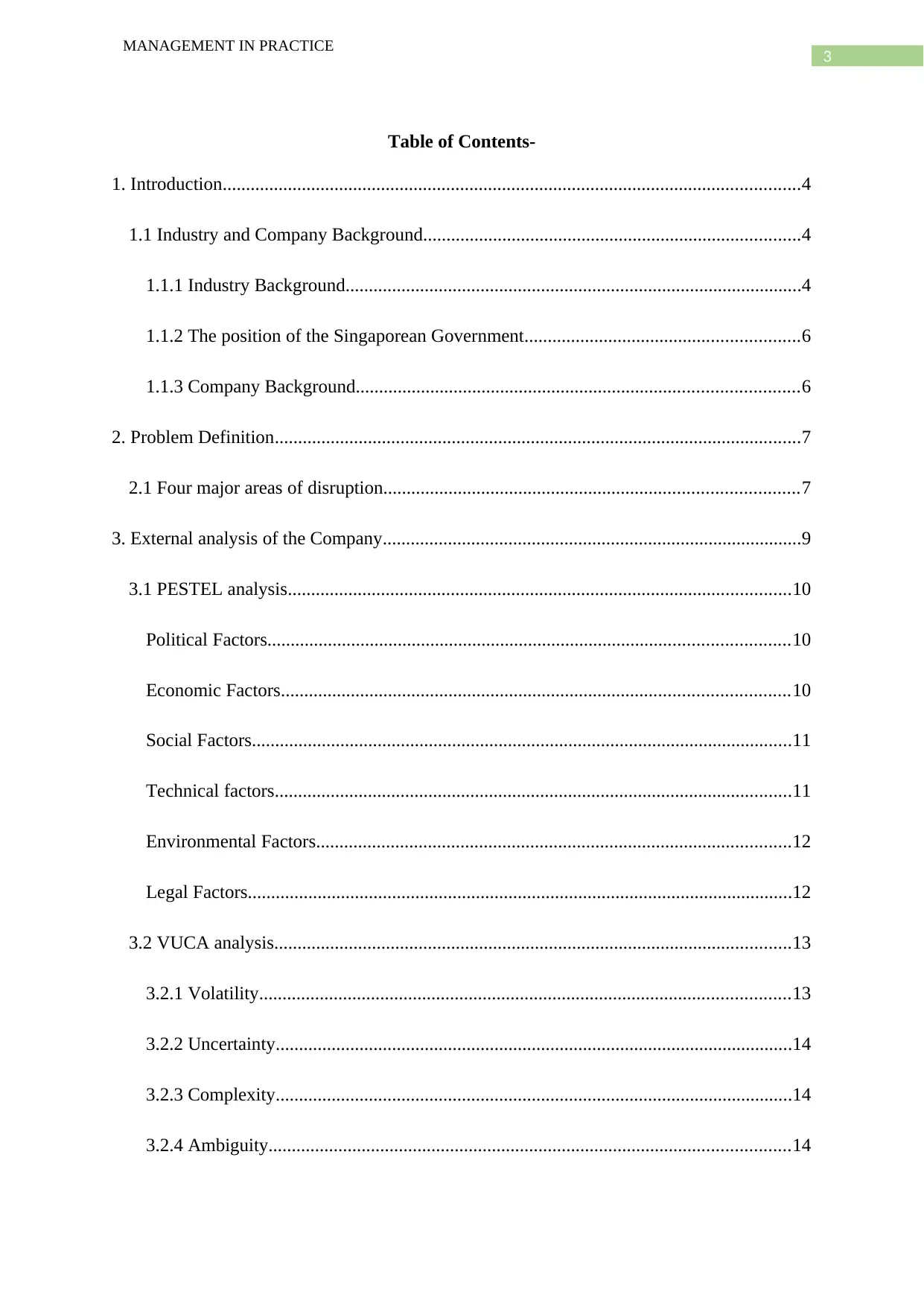
3
MANAGEMENT IN PRACTICE
Table of Contents-
1. Introduction............................................................................................................................4
1.1 Industry and Company Background.................................................................................4
1.1.1 Industry Background..................................................................................................4
1.1.2 The position of the Singaporean Government...........................................................6
1.1.3 Company Background...............................................................................................6
2. Problem Definition.................................................................................................................7
2.1 Four major areas of disruption.........................................................................................7
3. External analysis of the Company..........................................................................................9
3.1 PESTEL analysis............................................................................................................10
Political Factors................................................................................................................10
Economic Factors.............................................................................................................10
Social Factors....................................................................................................................11
Technical factors...............................................................................................................11
Environmental Factors......................................................................................................12
Legal Factors.....................................................................................................................12
3.2 VUCA analysis...............................................................................................................13
3.2.1 Volatility..................................................................................................................13
3.2.2 Uncertainty...............................................................................................................14
3.2.3 Complexity...............................................................................................................14
3.2.4 Ambiguity................................................................................................................14
MANAGEMENT IN PRACTICE
Table of Contents-
1. Introduction............................................................................................................................4
1.1 Industry and Company Background.................................................................................4
1.1.1 Industry Background..................................................................................................4
1.1.2 The position of the Singaporean Government...........................................................6
1.1.3 Company Background...............................................................................................6
2. Problem Definition.................................................................................................................7
2.1 Four major areas of disruption.........................................................................................7
3. External analysis of the Company..........................................................................................9
3.1 PESTEL analysis............................................................................................................10
Political Factors................................................................................................................10
Economic Factors.............................................................................................................10
Social Factors....................................................................................................................11
Technical factors...............................................................................................................11
Environmental Factors......................................................................................................12
Legal Factors.....................................................................................................................12
3.2 VUCA analysis...............................................................................................................13
3.2.1 Volatility..................................................................................................................13
3.2.2 Uncertainty...............................................................................................................14
3.2.3 Complexity...............................................................................................................14
3.2.4 Ambiguity................................................................................................................14
⊘ This is a preview!⊘
Do you want full access?
Subscribe today to unlock all pages.

Trusted by 1+ million students worldwide
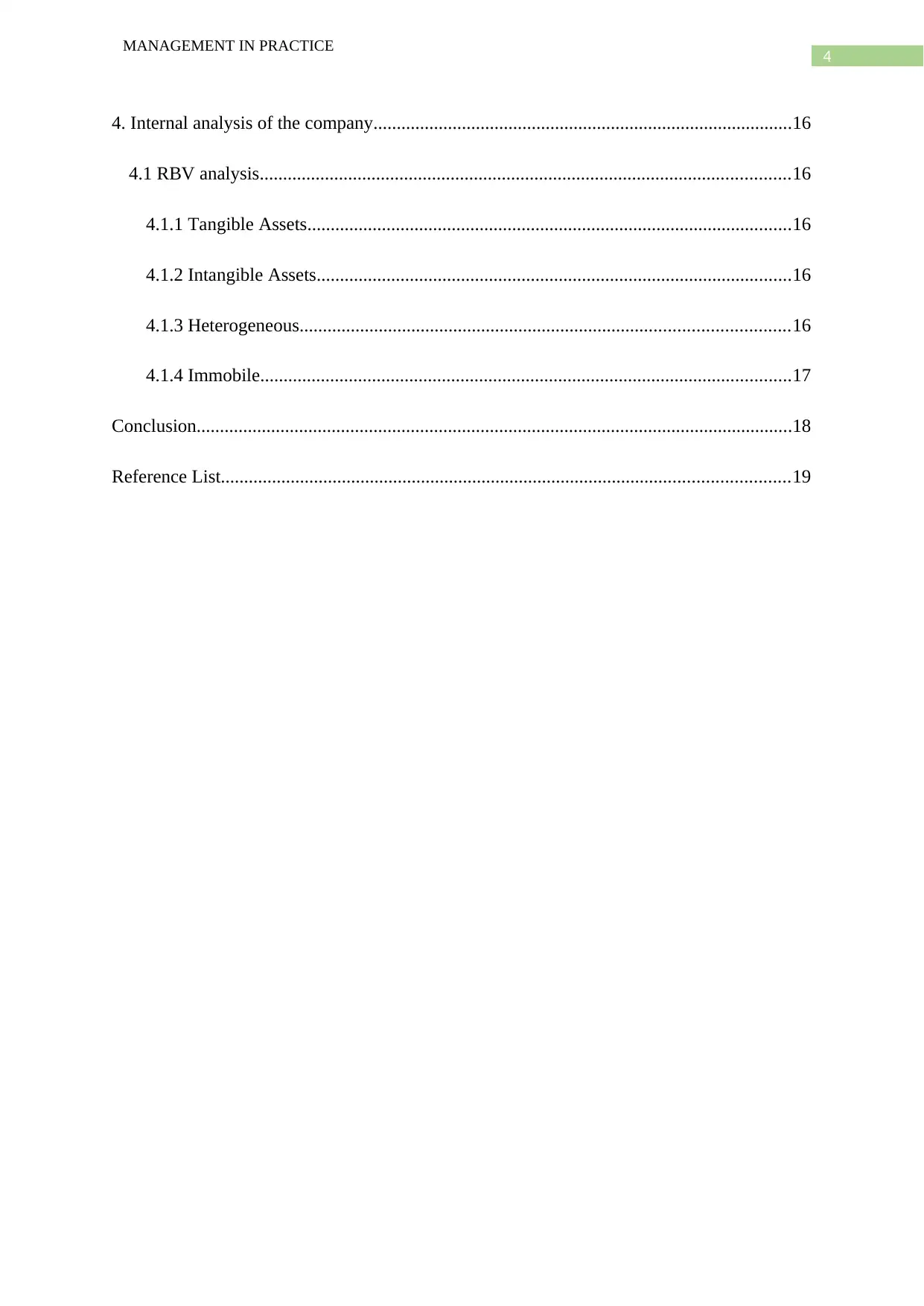
4
MANAGEMENT IN PRACTICE
4. Internal analysis of the company..........................................................................................16
4.1 RBV analysis..................................................................................................................16
4.1.1 Tangible Assets........................................................................................................16
4.1.2 Intangible Assets......................................................................................................16
4.1.3 Heterogeneous.........................................................................................................16
4.1.4 Immobile..................................................................................................................17
Conclusion................................................................................................................................18
Reference List..........................................................................................................................19
MANAGEMENT IN PRACTICE
4. Internal analysis of the company..........................................................................................16
4.1 RBV analysis..................................................................................................................16
4.1.1 Tangible Assets........................................................................................................16
4.1.2 Intangible Assets......................................................................................................16
4.1.3 Heterogeneous.........................................................................................................16
4.1.4 Immobile..................................................................................................................17
Conclusion................................................................................................................................18
Reference List..........................................................................................................................19
Paraphrase This Document
Need a fresh take? Get an instant paraphrase of this document with our AI Paraphraser
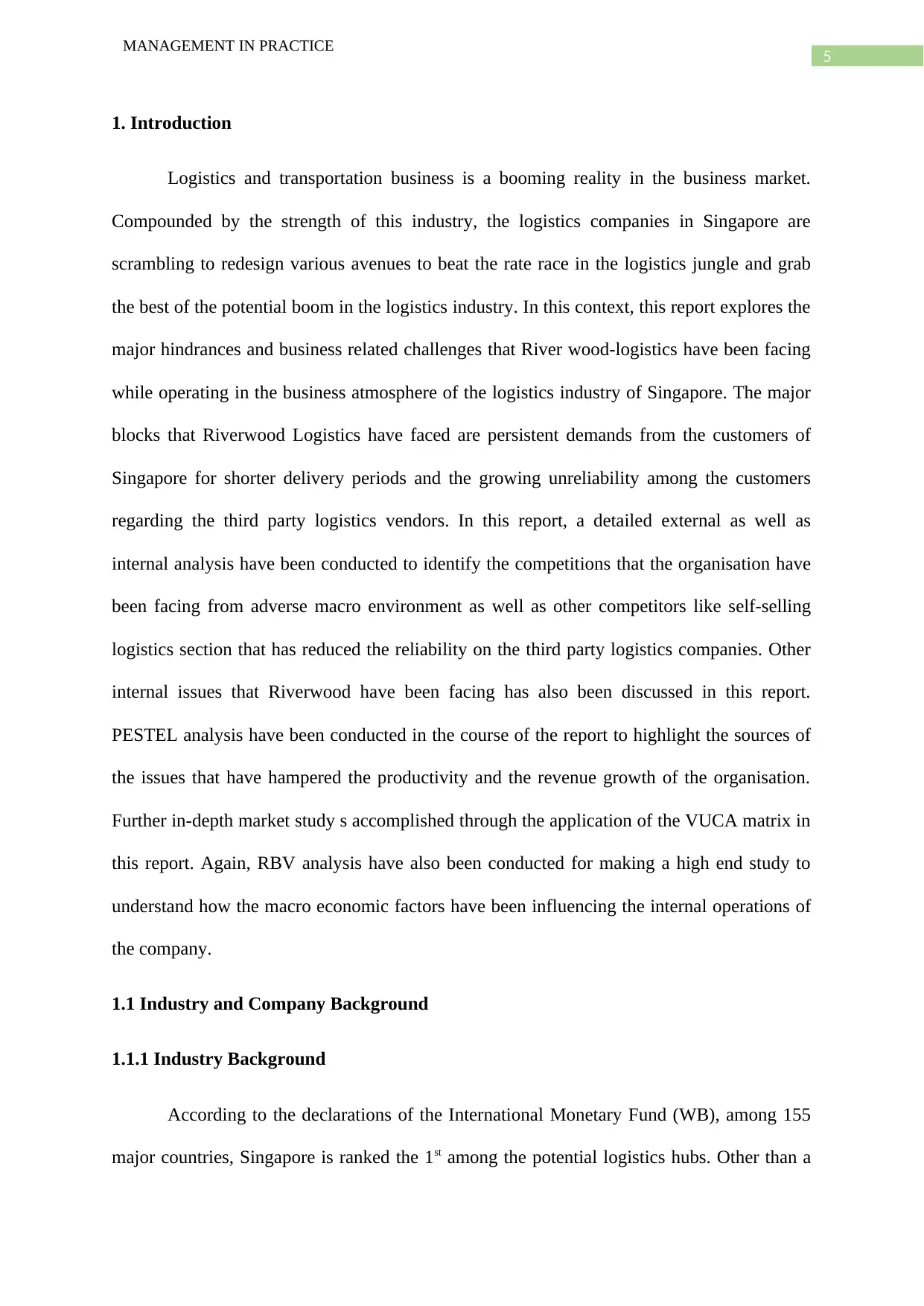
5
MANAGEMENT IN PRACTICE
1. Introduction
Logistics and transportation business is a booming reality in the business market.
Compounded by the strength of this industry, the logistics companies in Singapore are
scrambling to redesign various avenues to beat the rate race in the logistics jungle and grab
the best of the potential boom in the logistics industry. In this context, this report explores the
major hindrances and business related challenges that River wood-logistics have been facing
while operating in the business atmosphere of the logistics industry of Singapore. The major
blocks that Riverwood Logistics have faced are persistent demands from the customers of
Singapore for shorter delivery periods and the growing unreliability among the customers
regarding the third party logistics vendors. In this report, a detailed external as well as
internal analysis have been conducted to identify the competitions that the organisation have
been facing from adverse macro environment as well as other competitors like self-selling
logistics section that has reduced the reliability on the third party logistics companies. Other
internal issues that Riverwood have been facing has also been discussed in this report.
PESTEL analysis have been conducted in the course of the report to highlight the sources of
the issues that have hampered the productivity and the revenue growth of the organisation.
Further in-depth market study s accomplished through the application of the VUCA matrix in
this report. Again, RBV analysis have also been conducted for making a high end study to
understand how the macro economic factors have been influencing the internal operations of
the company.
1.1 Industry and Company Background
1.1.1 Industry Background
According to the declarations of the International Monetary Fund (WB), among 155
major countries, Singapore is ranked the 1st among the potential logistics hubs. Other than a
MANAGEMENT IN PRACTICE
1. Introduction
Logistics and transportation business is a booming reality in the business market.
Compounded by the strength of this industry, the logistics companies in Singapore are
scrambling to redesign various avenues to beat the rate race in the logistics jungle and grab
the best of the potential boom in the logistics industry. In this context, this report explores the
major hindrances and business related challenges that River wood-logistics have been facing
while operating in the business atmosphere of the logistics industry of Singapore. The major
blocks that Riverwood Logistics have faced are persistent demands from the customers of
Singapore for shorter delivery periods and the growing unreliability among the customers
regarding the third party logistics vendors. In this report, a detailed external as well as
internal analysis have been conducted to identify the competitions that the organisation have
been facing from adverse macro environment as well as other competitors like self-selling
logistics section that has reduced the reliability on the third party logistics companies. Other
internal issues that Riverwood have been facing has also been discussed in this report.
PESTEL analysis have been conducted in the course of the report to highlight the sources of
the issues that have hampered the productivity and the revenue growth of the organisation.
Further in-depth market study s accomplished through the application of the VUCA matrix in
this report. Again, RBV analysis have also been conducted for making a high end study to
understand how the macro economic factors have been influencing the internal operations of
the company.
1.1 Industry and Company Background
1.1.1 Industry Background
According to the declarations of the International Monetary Fund (WB), among 155
major countries, Singapore is ranked the 1st among the potential logistics hubs. Other than a
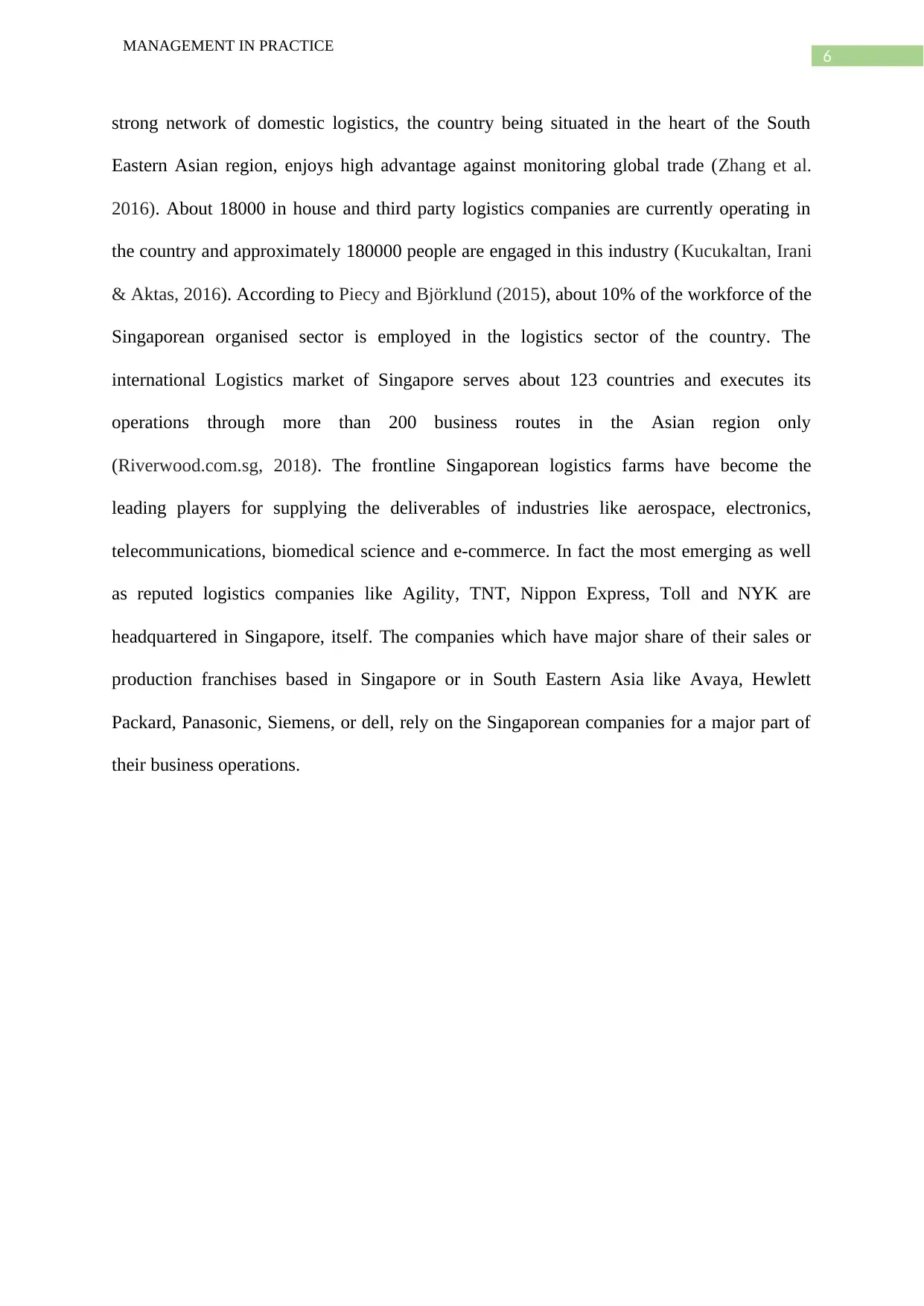
6
MANAGEMENT IN PRACTICE
strong network of domestic logistics, the country being situated in the heart of the South
Eastern Asian region, enjoys high advantage against monitoring global trade (Zhang et al.
2016). About 18000 in house and third party logistics companies are currently operating in
the country and approximately 180000 people are engaged in this industry (Kucukaltan, Irani
& Aktas, 2016). According to Piecy and Björklund (2015), about 10% of the workforce of the
Singaporean organised sector is employed in the logistics sector of the country. The
international Logistics market of Singapore serves about 123 countries and executes its
operations through more than 200 business routes in the Asian region only
(Riverwood.com.sg, 2018). The frontline Singaporean logistics farms have become the
leading players for supplying the deliverables of industries like aerospace, electronics,
telecommunications, biomedical science and e-commerce. In fact the most emerging as well
as reputed logistics companies like Agility, TNT, Nippon Express, Toll and NYK are
headquartered in Singapore, itself. The companies which have major share of their sales or
production franchises based in Singapore or in South Eastern Asia like Avaya, Hewlett
Packard, Panasonic, Siemens, or dell, rely on the Singaporean companies for a major part of
their business operations.
MANAGEMENT IN PRACTICE
strong network of domestic logistics, the country being situated in the heart of the South
Eastern Asian region, enjoys high advantage against monitoring global trade (Zhang et al.
2016). About 18000 in house and third party logistics companies are currently operating in
the country and approximately 180000 people are engaged in this industry (Kucukaltan, Irani
& Aktas, 2016). According to Piecy and Björklund (2015), about 10% of the workforce of the
Singaporean organised sector is employed in the logistics sector of the country. The
international Logistics market of Singapore serves about 123 countries and executes its
operations through more than 200 business routes in the Asian region only
(Riverwood.com.sg, 2018). The frontline Singaporean logistics farms have become the
leading players for supplying the deliverables of industries like aerospace, electronics,
telecommunications, biomedical science and e-commerce. In fact the most emerging as well
as reputed logistics companies like Agility, TNT, Nippon Express, Toll and NYK are
headquartered in Singapore, itself. The companies which have major share of their sales or
production franchises based in Singapore or in South Eastern Asia like Avaya, Hewlett
Packard, Panasonic, Siemens, or dell, rely on the Singaporean companies for a major part of
their business operations.
⊘ This is a preview!⊘
Do you want full access?
Subscribe today to unlock all pages.

Trusted by 1+ million students worldwide
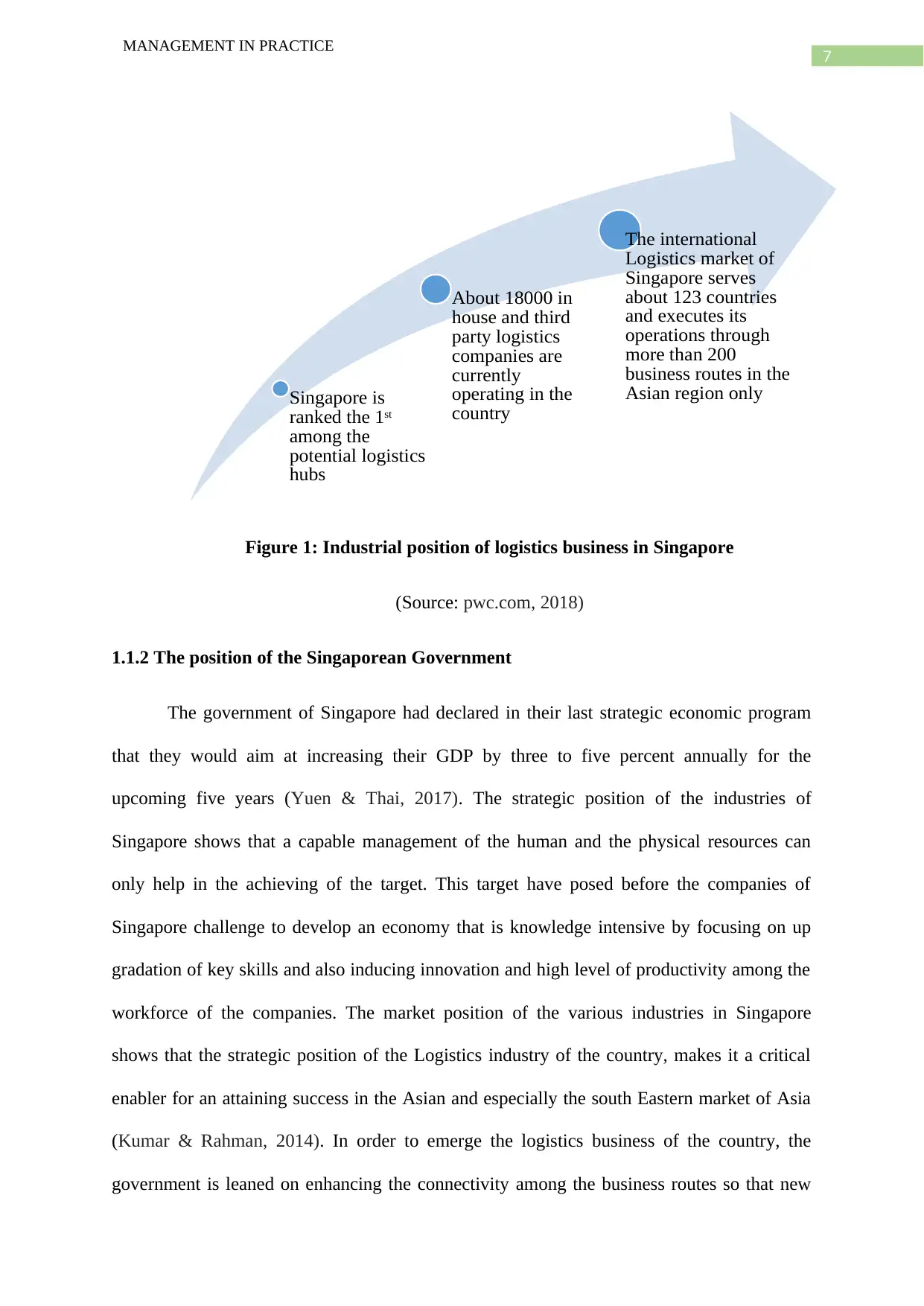
7
MANAGEMENT IN PRACTICE
Figure 1: Industrial position of logistics business in Singapore
(Source: pwc.com, 2018)
1.1.2 The position of the Singaporean Government
The government of Singapore had declared in their last strategic economic program
that they would aim at increasing their GDP by three to five percent annually for the
upcoming five years (Yuen & Thai, 2017). The strategic position of the industries of
Singapore shows that a capable management of the human and the physical resources can
only help in the achieving of the target. This target have posed before the companies of
Singapore challenge to develop an economy that is knowledge intensive by focusing on up
gradation of key skills and also inducing innovation and high level of productivity among the
workforce of the companies. The market position of the various industries in Singapore
shows that the strategic position of the Logistics industry of the country, makes it a critical
enabler for an attaining success in the Asian and especially the south Eastern market of Asia
(Kumar & Rahman, 2014). In order to emerge the logistics business of the country, the
government is leaned on enhancing the connectivity among the business routes so that new
Singapore is
ranked the 1 st
among the
potential logistics
hubs
About 18000 in
house and third
party logistics
companies are
currently
operating in the
country
The international
Logistics market of
Singapore serves
about 123 countries
and executes its
operations through
more than 200
business routes in the
Asian region only
MANAGEMENT IN PRACTICE
Figure 1: Industrial position of logistics business in Singapore
(Source: pwc.com, 2018)
1.1.2 The position of the Singaporean Government
The government of Singapore had declared in their last strategic economic program
that they would aim at increasing their GDP by three to five percent annually for the
upcoming five years (Yuen & Thai, 2017). The strategic position of the industries of
Singapore shows that a capable management of the human and the physical resources can
only help in the achieving of the target. This target have posed before the companies of
Singapore challenge to develop an economy that is knowledge intensive by focusing on up
gradation of key skills and also inducing innovation and high level of productivity among the
workforce of the companies. The market position of the various industries in Singapore
shows that the strategic position of the Logistics industry of the country, makes it a critical
enabler for an attaining success in the Asian and especially the south Eastern market of Asia
(Kumar & Rahman, 2014). In order to emerge the logistics business of the country, the
government is leaned on enhancing the connectivity among the business routes so that new
Singapore is
ranked the 1 st
among the
potential logistics
hubs
About 18000 in
house and third
party logistics
companies are
currently
operating in the
country
The international
Logistics market of
Singapore serves
about 123 countries
and executes its
operations through
more than 200
business routes in the
Asian region only
Paraphrase This Document
Need a fresh take? Get an instant paraphrase of this document with our AI Paraphraser
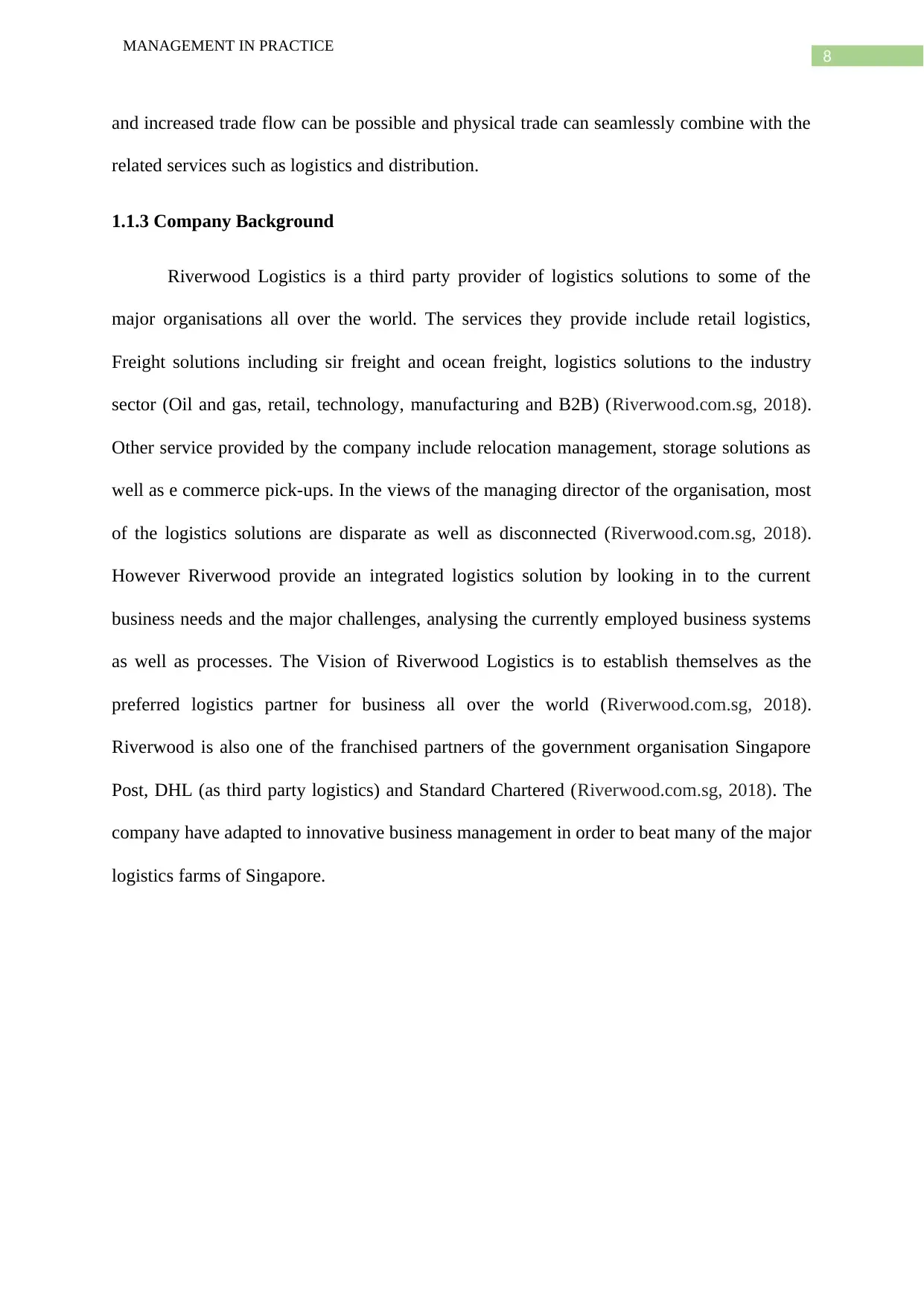
8
MANAGEMENT IN PRACTICE
and increased trade flow can be possible and physical trade can seamlessly combine with the
related services such as logistics and distribution.
1.1.3 Company Background
Riverwood Logistics is a third party provider of logistics solutions to some of the
major organisations all over the world. The services they provide include retail logistics,
Freight solutions including sir freight and ocean freight, logistics solutions to the industry
sector (Oil and gas, retail, technology, manufacturing and B2B) (Riverwood.com.sg, 2018).
Other service provided by the company include relocation management, storage solutions as
well as e commerce pick-ups. In the views of the managing director of the organisation, most
of the logistics solutions are disparate as well as disconnected (Riverwood.com.sg, 2018).
However Riverwood provide an integrated logistics solution by looking in to the current
business needs and the major challenges, analysing the currently employed business systems
as well as processes. The Vision of Riverwood Logistics is to establish themselves as the
preferred logistics partner for business all over the world (Riverwood.com.sg, 2018).
Riverwood is also one of the franchised partners of the government organisation Singapore
Post, DHL (as third party logistics) and Standard Chartered (Riverwood.com.sg, 2018). The
company have adapted to innovative business management in order to beat many of the major
logistics farms of Singapore.
MANAGEMENT IN PRACTICE
and increased trade flow can be possible and physical trade can seamlessly combine with the
related services such as logistics and distribution.
1.1.3 Company Background
Riverwood Logistics is a third party provider of logistics solutions to some of the
major organisations all over the world. The services they provide include retail logistics,
Freight solutions including sir freight and ocean freight, logistics solutions to the industry
sector (Oil and gas, retail, technology, manufacturing and B2B) (Riverwood.com.sg, 2018).
Other service provided by the company include relocation management, storage solutions as
well as e commerce pick-ups. In the views of the managing director of the organisation, most
of the logistics solutions are disparate as well as disconnected (Riverwood.com.sg, 2018).
However Riverwood provide an integrated logistics solution by looking in to the current
business needs and the major challenges, analysing the currently employed business systems
as well as processes. The Vision of Riverwood Logistics is to establish themselves as the
preferred logistics partner for business all over the world (Riverwood.com.sg, 2018).
Riverwood is also one of the franchised partners of the government organisation Singapore
Post, DHL (as third party logistics) and Standard Chartered (Riverwood.com.sg, 2018). The
company have adapted to innovative business management in order to beat many of the major
logistics farms of Singapore.
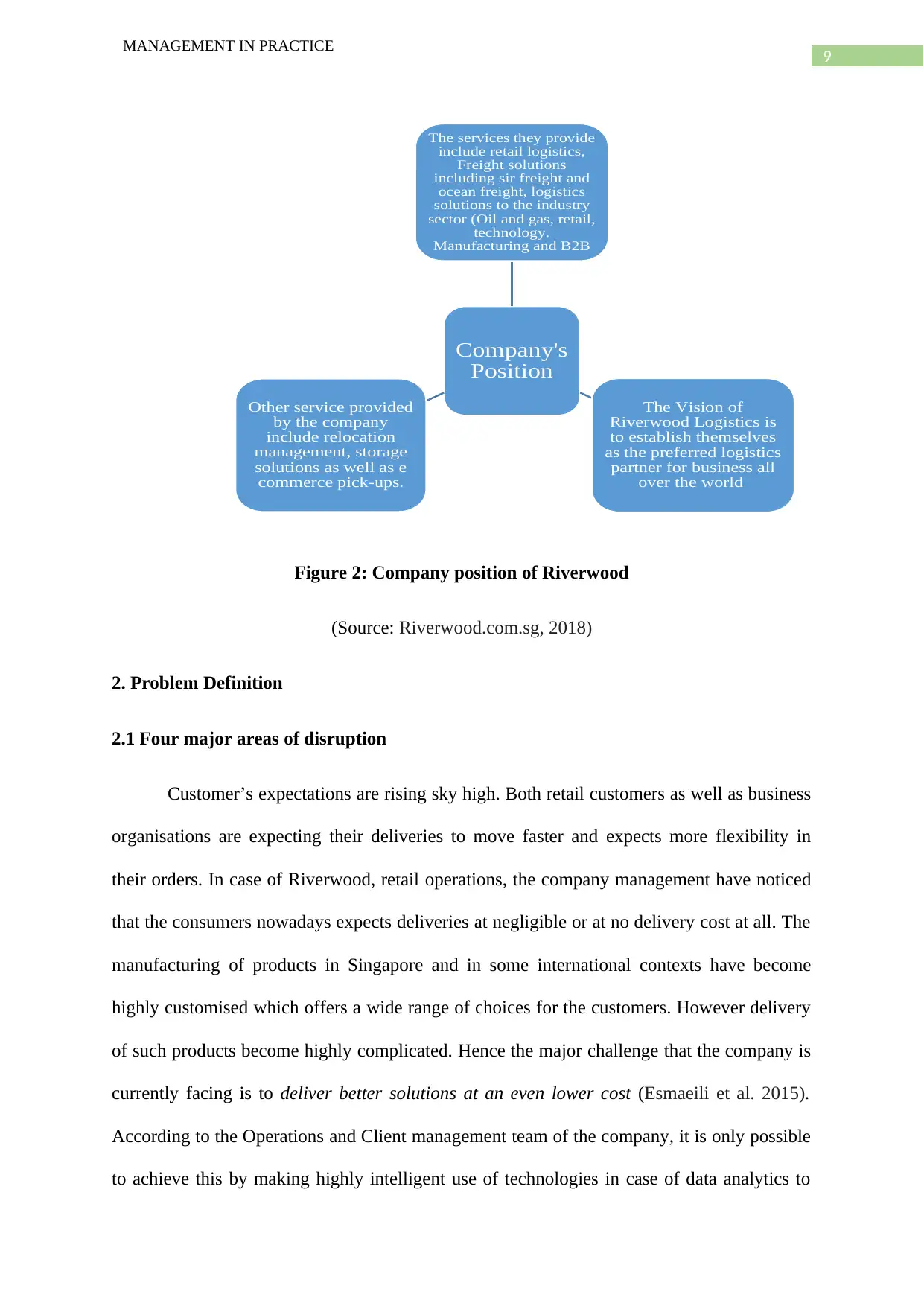
9
MANAGEMENT IN PRACTICE
Figure 2: Company position of Riverwood
(Source: Riverwood.com.sg, 2018)
2. Problem Definition
2.1 Four major areas of disruption
Customer’s expectations are rising sky high. Both retail customers as well as business
organisations are expecting their deliveries to move faster and expects more flexibility in
their orders. In case of Riverwood, retail operations, the company management have noticed
that the consumers nowadays expects deliveries at negligible or at no delivery cost at all. The
manufacturing of products in Singapore and in some international contexts have become
highly customised which offers a wide range of choices for the customers. However delivery
of such products become highly complicated. Hence the major challenge that the company is
currently facing is to deliver better solutions at an even lower cost (Esmaeili et al. 2015).
According to the Operations and Client management team of the company, it is only possible
to achieve this by making highly intelligent use of technologies in case of data analytics to
Company's
Position
The services they provide
include retail logistics,
Freight solutions
including sir freight and
ocean freight, logistics
solutions to the industry
sector (Oil and gas, retail,
technology.
Manufacturing and B2B
The Vision of
Riverwood Logistics is
to establish themselves
as the preferred logistics
partner for business all
over the world
Other service provided
by the company
include relocation
management, storage
solutions as well as e
commerce pick-ups .
MANAGEMENT IN PRACTICE
Figure 2: Company position of Riverwood
(Source: Riverwood.com.sg, 2018)
2. Problem Definition
2.1 Four major areas of disruption
Customer’s expectations are rising sky high. Both retail customers as well as business
organisations are expecting their deliveries to move faster and expects more flexibility in
their orders. In case of Riverwood, retail operations, the company management have noticed
that the consumers nowadays expects deliveries at negligible or at no delivery cost at all. The
manufacturing of products in Singapore and in some international contexts have become
highly customised which offers a wide range of choices for the customers. However delivery
of such products become highly complicated. Hence the major challenge that the company is
currently facing is to deliver better solutions at an even lower cost (Esmaeili et al. 2015).
According to the Operations and Client management team of the company, it is only possible
to achieve this by making highly intelligent use of technologies in case of data analytics to
Company's
Position
The services they provide
include retail logistics,
Freight solutions
including sir freight and
ocean freight, logistics
solutions to the industry
sector (Oil and gas, retail,
technology.
Manufacturing and B2B
The Vision of
Riverwood Logistics is
to establish themselves
as the preferred logistics
partner for business all
over the world
Other service provided
by the company
include relocation
management, storage
solutions as well as e
commerce pick-ups .
⊘ This is a preview!⊘
Do you want full access?
Subscribe today to unlock all pages.

Trusted by 1+ million students worldwide
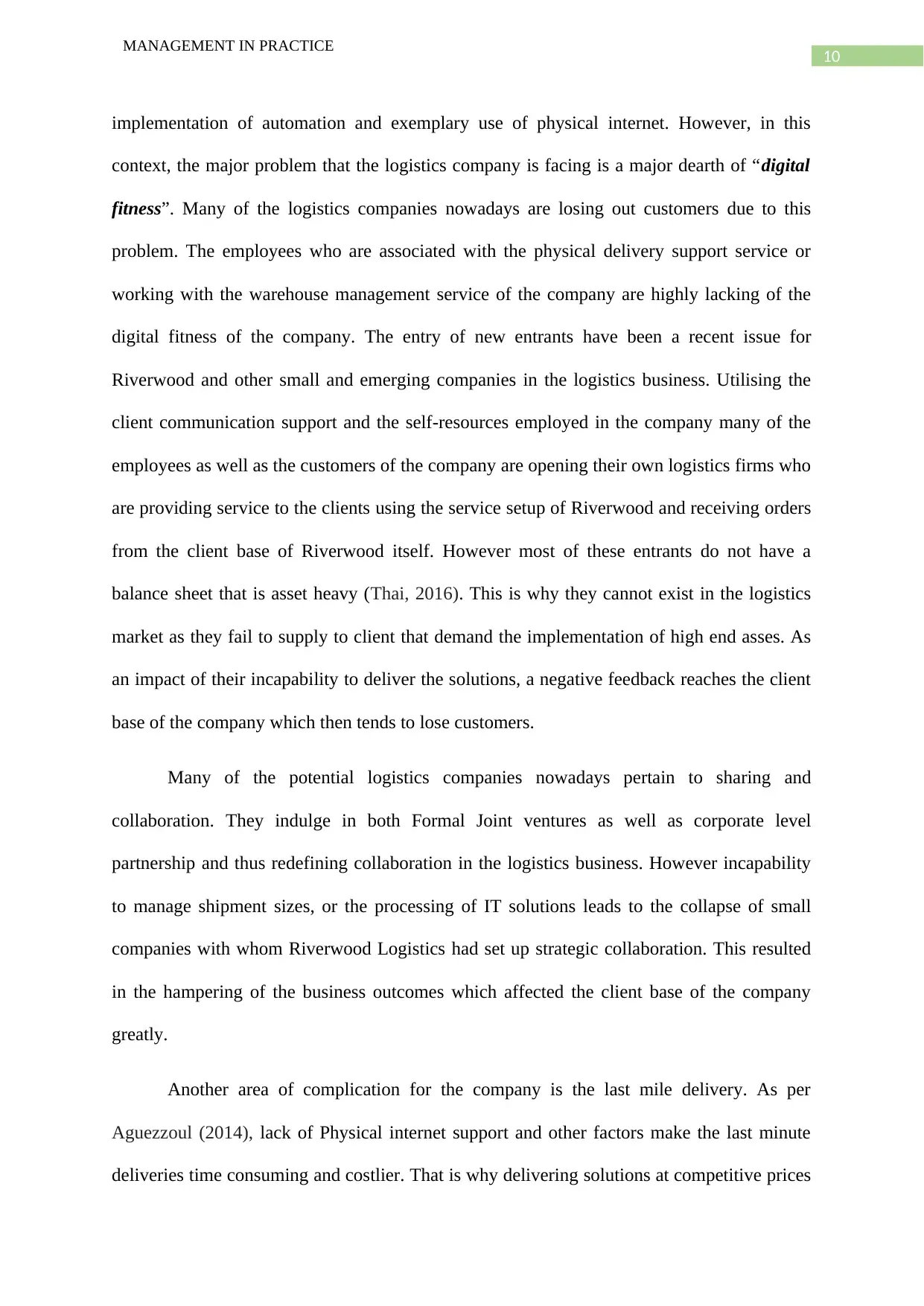
10
MANAGEMENT IN PRACTICE
implementation of automation and exemplary use of physical internet. However, in this
context, the major problem that the logistics company is facing is a major dearth of “digital
fitness”. Many of the logistics companies nowadays are losing out customers due to this
problem. The employees who are associated with the physical delivery support service or
working with the warehouse management service of the company are highly lacking of the
digital fitness of the company. The entry of new entrants have been a recent issue for
Riverwood and other small and emerging companies in the logistics business. Utilising the
client communication support and the self-resources employed in the company many of the
employees as well as the customers of the company are opening their own logistics firms who
are providing service to the clients using the service setup of Riverwood and receiving orders
from the client base of Riverwood itself. However most of these entrants do not have a
balance sheet that is asset heavy (Thai, 2016). This is why they cannot exist in the logistics
market as they fail to supply to client that demand the implementation of high end asses. As
an impact of their incapability to deliver the solutions, a negative feedback reaches the client
base of the company which then tends to lose customers.
Many of the potential logistics companies nowadays pertain to sharing and
collaboration. They indulge in both Formal Joint ventures as well as corporate level
partnership and thus redefining collaboration in the logistics business. However incapability
to manage shipment sizes, or the processing of IT solutions leads to the collapse of small
companies with whom Riverwood Logistics had set up strategic collaboration. This resulted
in the hampering of the business outcomes which affected the client base of the company
greatly.
Another area of complication for the company is the last mile delivery. As per
Aguezzoul (2014), lack of Physical internet support and other factors make the last minute
deliveries time consuming and costlier. That is why delivering solutions at competitive prices
MANAGEMENT IN PRACTICE
implementation of automation and exemplary use of physical internet. However, in this
context, the major problem that the logistics company is facing is a major dearth of “digital
fitness”. Many of the logistics companies nowadays are losing out customers due to this
problem. The employees who are associated with the physical delivery support service or
working with the warehouse management service of the company are highly lacking of the
digital fitness of the company. The entry of new entrants have been a recent issue for
Riverwood and other small and emerging companies in the logistics business. Utilising the
client communication support and the self-resources employed in the company many of the
employees as well as the customers of the company are opening their own logistics firms who
are providing service to the clients using the service setup of Riverwood and receiving orders
from the client base of Riverwood itself. However most of these entrants do not have a
balance sheet that is asset heavy (Thai, 2016). This is why they cannot exist in the logistics
market as they fail to supply to client that demand the implementation of high end asses. As
an impact of their incapability to deliver the solutions, a negative feedback reaches the client
base of the company which then tends to lose customers.
Many of the potential logistics companies nowadays pertain to sharing and
collaboration. They indulge in both Formal Joint ventures as well as corporate level
partnership and thus redefining collaboration in the logistics business. However incapability
to manage shipment sizes, or the processing of IT solutions leads to the collapse of small
companies with whom Riverwood Logistics had set up strategic collaboration. This resulted
in the hampering of the business outcomes which affected the client base of the company
greatly.
Another area of complication for the company is the last mile delivery. As per
Aguezzoul (2014), lack of Physical internet support and other factors make the last minute
deliveries time consuming and costlier. That is why delivering solutions at competitive prices
Paraphrase This Document
Need a fresh take? Get an instant paraphrase of this document with our AI Paraphraser
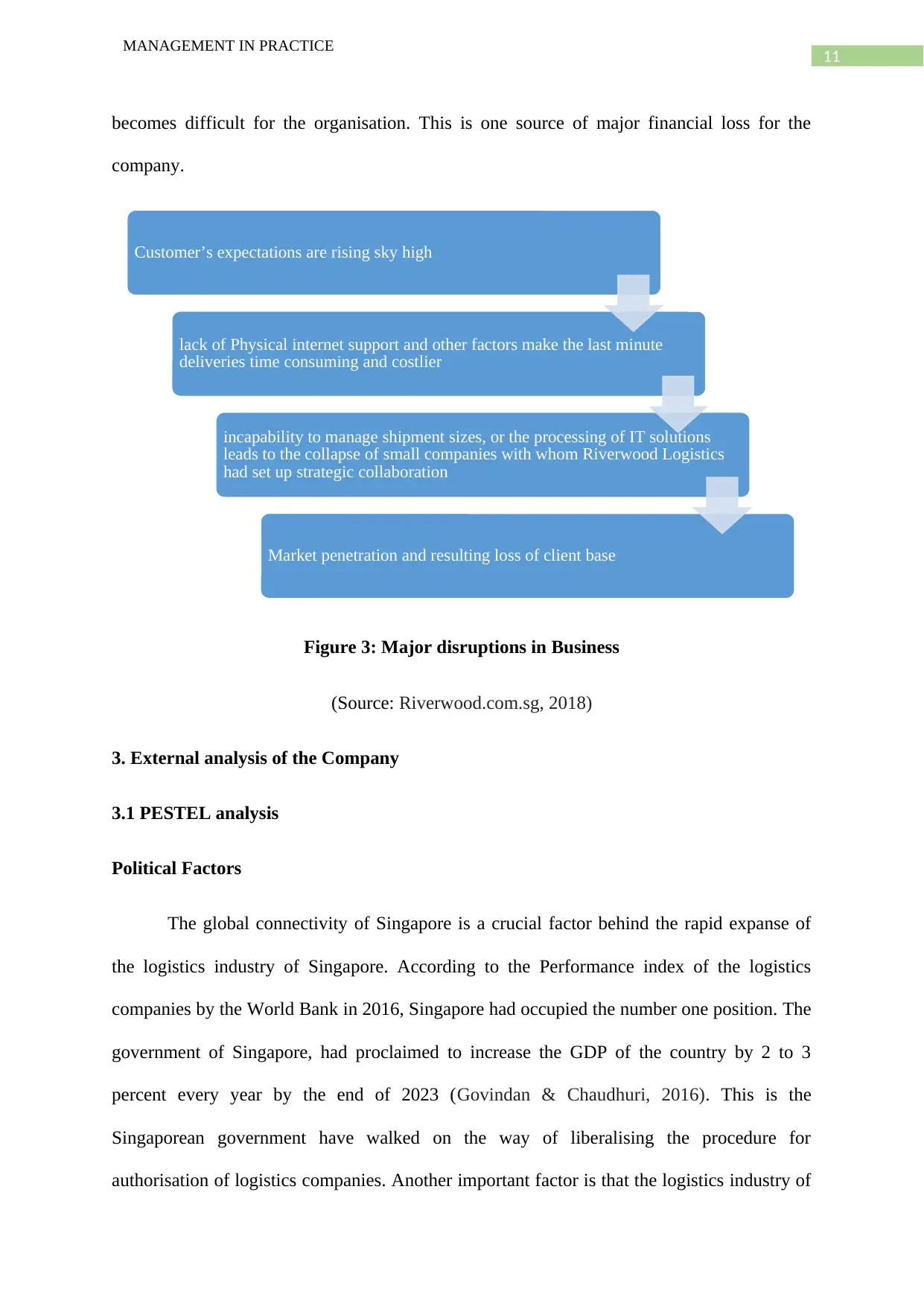
11
MANAGEMENT IN PRACTICE
becomes difficult for the organisation. This is one source of major financial loss for the
company.
Figure 3: Major disruptions in Business
(Source: Riverwood.com.sg, 2018)
3. External analysis of the Company
3.1 PESTEL analysis
Political Factors
The global connectivity of Singapore is a crucial factor behind the rapid expanse of
the logistics industry of Singapore. According to the Performance index of the logistics
companies by the World Bank in 2016, Singapore had occupied the number one position. The
government of Singapore, had proclaimed to increase the GDP of the country by 2 to 3
percent every year by the end of 2023 (Govindan & Chaudhuri, 2016). This is the
Singaporean government have walked on the way of liberalising the procedure for
authorisation of logistics companies. Another important factor is that the logistics industry of
Customer’s expectations are rising sky high
lack of Physical internet support and other factors make the last minute
deliveries time consuming and costlier
incapability to manage shipment sizes, or the processing of IT solutions
leads to the collapse of small companies with whom Riverwood Logistics
had set up strategic collaboration
Market penetration and resulting loss of client base
MANAGEMENT IN PRACTICE
becomes difficult for the organisation. This is one source of major financial loss for the
company.
Figure 3: Major disruptions in Business
(Source: Riverwood.com.sg, 2018)
3. External analysis of the Company
3.1 PESTEL analysis
Political Factors
The global connectivity of Singapore is a crucial factor behind the rapid expanse of
the logistics industry of Singapore. According to the Performance index of the logistics
companies by the World Bank in 2016, Singapore had occupied the number one position. The
government of Singapore, had proclaimed to increase the GDP of the country by 2 to 3
percent every year by the end of 2023 (Govindan & Chaudhuri, 2016). This is the
Singaporean government have walked on the way of liberalising the procedure for
authorisation of logistics companies. Another important factor is that the logistics industry of
Customer’s expectations are rising sky high
lack of Physical internet support and other factors make the last minute
deliveries time consuming and costlier
incapability to manage shipment sizes, or the processing of IT solutions
leads to the collapse of small companies with whom Riverwood Logistics
had set up strategic collaboration
Market penetration and resulting loss of client base
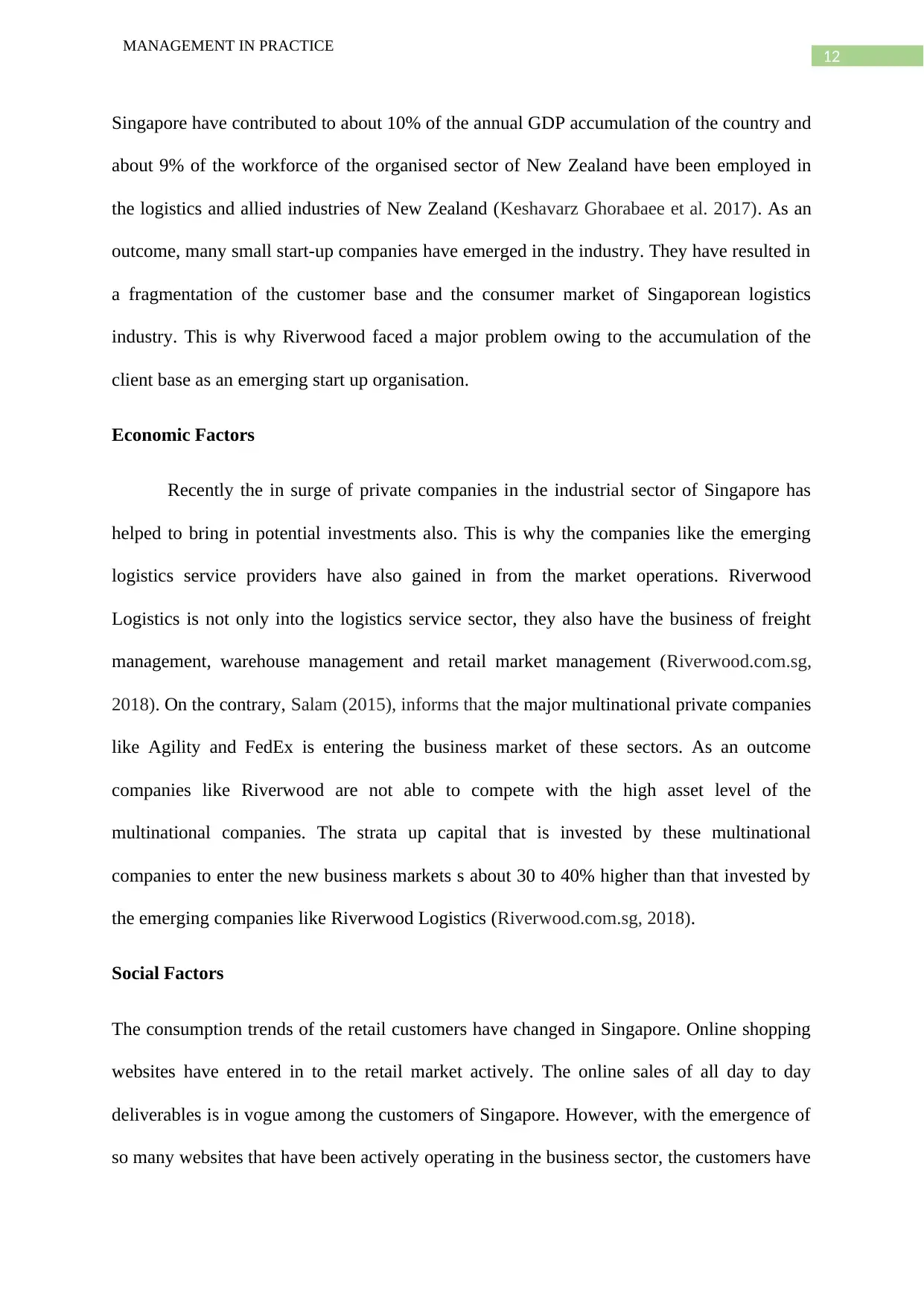
12
MANAGEMENT IN PRACTICE
Singapore have contributed to about 10% of the annual GDP accumulation of the country and
about 9% of the workforce of the organised sector of New Zealand have been employed in
the logistics and allied industries of New Zealand (Keshavarz Ghorabaee et al. 2017). As an
outcome, many small start-up companies have emerged in the industry. They have resulted in
a fragmentation of the customer base and the consumer market of Singaporean logistics
industry. This is why Riverwood faced a major problem owing to the accumulation of the
client base as an emerging start up organisation.
Economic Factors
Recently the in surge of private companies in the industrial sector of Singapore has
helped to bring in potential investments also. This is why the companies like the emerging
logistics service providers have also gained in from the market operations. Riverwood
Logistics is not only into the logistics service sector, they also have the business of freight
management, warehouse management and retail market management (Riverwood.com.sg,
2018). On the contrary, Salam (2015), informs that the major multinational private companies
like Agility and FedEx is entering the business market of these sectors. As an outcome
companies like Riverwood are not able to compete with the high asset level of the
multinational companies. The strata up capital that is invested by these multinational
companies to enter the new business markets s about 30 to 40% higher than that invested by
the emerging companies like Riverwood Logistics (Riverwood.com.sg, 2018).
Social Factors
The consumption trends of the retail customers have changed in Singapore. Online shopping
websites have entered in to the retail market actively. The online sales of all day to day
deliverables is in vogue among the customers of Singapore. However, with the emergence of
so many websites that have been actively operating in the business sector, the customers have
MANAGEMENT IN PRACTICE
Singapore have contributed to about 10% of the annual GDP accumulation of the country and
about 9% of the workforce of the organised sector of New Zealand have been employed in
the logistics and allied industries of New Zealand (Keshavarz Ghorabaee et al. 2017). As an
outcome, many small start-up companies have emerged in the industry. They have resulted in
a fragmentation of the customer base and the consumer market of Singaporean logistics
industry. This is why Riverwood faced a major problem owing to the accumulation of the
client base as an emerging start up organisation.
Economic Factors
Recently the in surge of private companies in the industrial sector of Singapore has
helped to bring in potential investments also. This is why the companies like the emerging
logistics service providers have also gained in from the market operations. Riverwood
Logistics is not only into the logistics service sector, they also have the business of freight
management, warehouse management and retail market management (Riverwood.com.sg,
2018). On the contrary, Salam (2015), informs that the major multinational private companies
like Agility and FedEx is entering the business market of these sectors. As an outcome
companies like Riverwood are not able to compete with the high asset level of the
multinational companies. The strata up capital that is invested by these multinational
companies to enter the new business markets s about 30 to 40% higher than that invested by
the emerging companies like Riverwood Logistics (Riverwood.com.sg, 2018).
Social Factors
The consumption trends of the retail customers have changed in Singapore. Online shopping
websites have entered in to the retail market actively. The online sales of all day to day
deliverables is in vogue among the customers of Singapore. However, with the emergence of
so many websites that have been actively operating in the business sector, the customers have
⊘ This is a preview!⊘
Do you want full access?
Subscribe today to unlock all pages.

Trusted by 1+ million students worldwide
1 out of 23
Related Documents
Your All-in-One AI-Powered Toolkit for Academic Success.
+13062052269
info@desklib.com
Available 24*7 on WhatsApp / Email
![[object Object]](/_next/static/media/star-bottom.7253800d.svg)
Unlock your academic potential
Copyright © 2020–2025 A2Z Services. All Rights Reserved. Developed and managed by ZUCOL.





